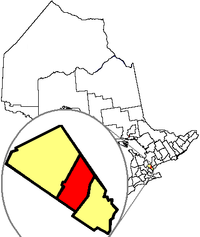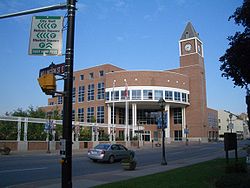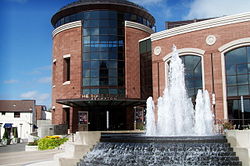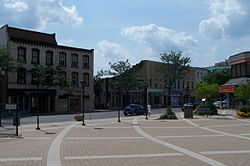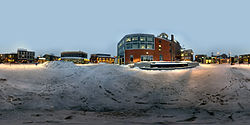- Brampton
-
For other places named Brampton, see Brampton (disambiguation).
Brampton — City — 
Flag
LogoNickname(s): Flower City (previously Flower Town[1]) Location in the Region of Peel, in the Province of Ontario Coordinates: 43°41′N 79°46′W / 43.683°N 79.767°WCoordinates: 43°41′N 79°46′W / 43.683°N 79.767°W Country  Canada
CanadaProvince  Ontario
OntarioRegion Peel Region Incorporation 1853 (village) 1873 (town) 1974 (city) Government – Mayor Susan Fennell – Governing Body Brampton City Council
(click for members)– MPs – MPPs List of MPPs- Vic Dhillon (OLP)
- Linda Jeffrey (OLP)
- Jagmeet Singh (ONDP)
- Amrit Mangat (OLP)
Area[2] – Land 266.71 km2 (103 sq mi) Population (2006)[2] – Total 433,806 (Ranked 11th) – Density 1,626.5/km2 (4,212.6/sq mi) Time zone EST (UTC−5) – Summer (DST) EDT (UTC−4) Forward sortation area L6P-L7A Area code(s) 905/289 Website www.brampton.ca Brampton (
 /ˈbræmptən/ or /ˈbræmtən/) is the third-largest city in the Greater Toronto Area (GTA) of Ontario, Canada and the seat of Peel Region. As of the 2006 census, Brampton's population stood at 433,806,[2] making it the 11th largest city in Canada. It is also one of Canada's fastest growing municipalities, with an average annual growth rate (2001–2006) of 6.6%. With the median age at 33.7, it is the youngest community in the GTA. It is estimated that in 2011 Brampton has 510,000 people. Brampton has the largest concentration of South Asians in Canada, making up 36% of Brampton's population.[3]
/ˈbræmptən/ or /ˈbræmtən/) is the third-largest city in the Greater Toronto Area (GTA) of Ontario, Canada and the seat of Peel Region. As of the 2006 census, Brampton's population stood at 433,806,[2] making it the 11th largest city in Canada. It is also one of Canada's fastest growing municipalities, with an average annual growth rate (2001–2006) of 6.6%. With the median age at 33.7, it is the youngest community in the GTA. It is estimated that in 2011 Brampton has 510,000 people. Brampton has the largest concentration of South Asians in Canada, making up 36% of Brampton's population.[3]Brampton was incorporated as a village in 1853, taking its name from the rural town of Brampton, in Cumbria, England. Brampton was once known as The Flower Town of Canada, a title it earned due to the city's large greenhouse industry. This included Dale's Flowers, a company that won many international rose awards for nearly half a century. Today, the city's major economic sectors include advanced manufacturing, retail administration and logistics, information and communication technologies, food and beverage, life sciences and business services. It houses the national headquarters of Loblaw Companies, HBC/Zellers, Bacardi, Brita, Clorox and other companies.
The city is home to Canadian Forces Army Reserve unit The Lorne Scots (Peel, Dufferin and Halton Regiment).
Contents
History
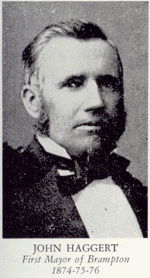 John Haggert, Brampton's first mayor
John Haggert, Brampton's first mayor Main article: History of Brampton
Main article: History of BramptonPrior to the 1800s, the only building of consequence at the corner of Main and Queen streets, the recognized centre of Brampton, was William Buffy's tavern. At the time, the area was referred to as "Buffy's Corners". All real business in Chinguacousy Township took place 1 mile distant at Martin Salisbury's tavern. By 1834, John Elliott laid out the area in lots for sale, and applied the name "Brampton" to the area, which was soon adopted by others.[4]
In 1853, a small agricultural fair was set up by the then-new County Agricultural Society of the County of Peel, and was held at the corner of Main and Queen streets. Grains, produce, roots, and dairy products were up for sale. Horses and cattle, along with other lesser livestock, were also sold at market. This agricultural fair eventually became the modern Brampton Fall Fair. In that same year Brampton was incorporated as a village.[4]
A federal grant allowed the village to create its first public library in 1887, which included 360 volumes from the Mechanic's Institute (est 1858). In 1907, the library successfully received a grant from United States steel magnate and philanthropist Andrew Carnegie to build a new multi-purpose building, featuring what is now the Brampton Library.
A group of regional farmers in Brampton had trouble getting insurance from city-based companies. After several meetings in Clairville Hall, they decided to found the County of Peel Farmers Mutual Fire Insurance Company. In 1955, the company moved to its third and current location, 103 Queen Street West, and took the new name of Peel Mutual Insurance Company. It reigns as the longest-running company in modern Brampton. Harmsworth Decorating Centre was established in 1890, as Harmsworth and Son, operated out of the family's house on Queen Street West. The current location was purchased on September 1, 1904, after a fire destroyed their original store. Purchased for $1,400, the 24 Main Street South location is the longest-operating retail business in what is now Brampton.
Edward Dale, an immigrant from Dorking, England, established a flower nursery in Brampton[5] shortly after his arrival in 1863.[6] Dale's Nursery became the town's largest[5] and most prominent employer, developed a flower grading system,[6] and established a global export market for its products.[5] The company chimney became a town landmark,[6] until Brampton Town Council allowed it to be torn down in 1977.[6] At its height, the company had 140 greenhouses,[7] and was the largest cut flower business in North America,[8] producing 20 million blooms and introducing numerous rose and orchid varietals and species to the market.[8] It also spurred the development of other nurseries in the town, as the town was once home to 48 hothouse flower nurseries.[6][8]
In 1963, the town established The Flower Festival of Brampton, based on the Rose Festival of Portland, Oregon, and began marketing itself as the Flower Town of Canada.[6] On 24 June 2002 City Council established the "Flower City Strategy",[9][10] to promote a link to its flower-growing heritage.[11] The construction of the Rose Theatre as a cultural institution in the city[6] and annual participation in the Communities in Bloom competition are part of that strategy.
Neighbouring Bramalea created
Main article: Bramalea, OntarioCreated as an innovative "new town", Bramalea was developed as a separate community, approximately 40 kilometres northwest of Toronto. Located in the former Chinguacousy Township, it was Canada's first satellite community developed by one of the country's largest real estate developers, Bramalea Limited, formerly known as Brampton Leasing. The name "Bramalea" was created by the farmer William Sheard, who combined "BRAM" from Brampton, "MAL" from Malton (a neighbouring region), and "LEA", an Old English word meaning meadow or grassland. He sold the land to Brampton Leasing developers and built one of Bramalea's first houses on Dixie Road across from the former headquarters of Nortel.
The community had an extensive master plan, which included provisions for a parkland trail system and a "downtown", which would include essential services and a shopping centre. The downtown area's centrepiece was the Civic Centre, which included the city hall and library. Directly across Team Canada Drive from the Civic Centre, Bramalea Limited built a shopping centre named Bramalea City Centre. The two centrepieces were connected by a long underground tunnel. This has long since been closed due to safety issues, and urbanists have also found that pedestrians make for livelier streets. Other features included a police station, fire hall, bus terminal, and a collection of seniors' retirement homes.
Each phase of the new city was marked with progressing first letters of street names. Development started with the "A" section, with street names such as Argyle, Avondale, and Aloma. Developer then created a "B" section, "C" section, and so forth. Children on the boundaries of these divisions would regularly compete in street hockey games, pitting, for example, the "D" section versus the "E" section.
The community was initially developed with a large number of recreational facilities, including tennis courts, playgrounds, hockey/lacrosse rinks and swimming pools. An extensive parkland trail and sidewalk system connects the entire city, amplifying what Brampton already had in a smaller scale.
Region of Peel
In 1974, the Ontario government decided to update Peel County's structure. Along with amalgamating a series of villages into the City of Mississauga, the new City of Brampton was created out of the greater portion of the Townships of Chinguacousy and Toronto Gore, including Bramalea and the other communities in those townships. The province converted Peel County into the Regional Municipality of Peel. Brampton retained its role as the administrative centre of Peel Region, which it already had as county seat. The regional council chamber, the Peel Regional Police force, the public health department, and the region's only major museum, the Peel Heritage Complex, are all located in Brampton.
This move was not met with wholesale approval. Bramptonians feared urban sprawl would dissolve their town's personality. Bramalea residents took pride in the built-from-scratch and organized structure that had come with their new city and did not want to give up their identity. Many people in Bramalea accept they are part of Brampton, and they make up the tri-city area. Brampton, Heart Lake, Bramalea.
In 1972, Bramalea created its civic centre. Two years after it was built, when Brampton and Bramalea merged, the new city's council chambers and other facilities were created in the building. They moved from the town of Brampton's modest downtown locale. The library systems of Brampton and Bramalea became one, creating a system of four locations.
Some have questioned the future of Peel Region as encompassing all of Brampton, Mississauga, and Caledon. Mississauga council, led by Mayor Hazel McCallion, voted in favour of becoming a single-tier municipality and asked the provincial government to be separated from Peel Region. They argued the city has outgrown the need for a regional layer of government, and that Mississauga is being held back by supporting Brampton and Caledon with its municipal taxes.
Development as a city
Chinguacousy and Toronto Gore were two townships incorporated into Brampton mid-way through the twentieth century. The small pine added to the center of the shield on the Brampton city flag represents Chinguacousy, thus continues honouring Chippewa chief Shinguacose, "The Small Pine." From this merger, communities such as Bramalea, Heart Lake and Professor's Lake, Snelgrove, Tullamore, and Mayfield, were formed. Bramalea was annexed into Brampton in 1974. Rural villages, such as Claireville, Ebenezer, Victoria, Springbrook, Churchville, Coleraine, and Huttonville were also merged into the larger city. While only Huttonville and Churchville still exist as identifiable communities, other names like Claireville are re-emerging as names of new developments.
The early 1980s brought new development, as the city released large tracts of land to residential developers. The large new suburban community of Springdale was developed in 1995 and is the area where most of the urban sprawl has taken place. This land began in its largest boom in 1999, when development started to appear as far north as the city's border with Caledon. The region has designated this border as being the line of demarcation for urban development until 2021. However, neighbouring communities not part of Peel have also been massively affected by the city's sudden spurt. The end of Brampton and start of Georgetown, for example, is essentially non-identifiable.
Also in the early 1980s, the Capitol Theatre, then owned by Odeon, closed its doors. The City bought the facility in 1981 under the spearhead of then-councillor Diane Sutter, turning the former movie house and vaudeville venue into a musical and performing arts theatre. It was renamed the Heritage Theatre. In 1983, Toronto consultants Woods Gordon reported to the City that, rather than continue "pouring money" into the Heritage, they should construct a new 750-seat facility. The 2005/06 season was designated as the Heritage theatre's "grand finale" season. The new Rose Theatre opened in September 2006.
Carabram was founded in 1984, after volunteers from different ethnic communities wanted to organize a festival celebrating diversity and cross-cultural friendship. With a name based on Toronto like-event, Caravan Festival of Cultures, Carabram's first event included Italian, Scots, Ukrainian, and West Indian pavilions. By 2003, the fair had 18 pavilions attracting 45,000 visitors. The national government of Canada had an anchor pavilion in the late 1980s and early 1990s. For Carabram's 25th Anniversary in 2009, Canada also had a pavilion.
With a growing multicultural population, the Peel Board of Education introduced evening English as a Second Language (ESL) classes at high schools. Originally taught by volunteers, the classes eventually became daytime courses taught by paid instructors. In the 1980s, the public and Catholic board expanded its languages programs, offering night classes in 23 languages. These were introduced by the urging of parents who wanted their children to learn their ancestral language and heritage. Brampton has a very large South Asian population, which is expected to grow at a high rate.
Spearheaded by then-Mayor Ken Whillans, the early 1990s brought a new city hall to Brampton's downtown. Whillans never got to see the opening of the new City hall because of his death in August of that same year. The move of City hall to downtown sparked a renewed interest by politicians and businesses alike to revitalize the downtown core. The facility was designed by local architects and constructed by Inzola Construction.
The Brampton Fair Grounds were sold in 1992 to the City of Brampton. The Agricultural Society relocated in 1997 to Heart Lake Road and Old School Road (outside the boundaries of the city).
The Health Services Restructuring Commission (HSRC) decided in 1997 that Georgetown and District Memorial Hospital, Etobicoke General Hospital and Peel Memorial Hospital should amalgamate into the William Osler Health Centre. It became what now is the province's 6th largest hospital corporation.
Brampton's 2003 Sesquicentennial celebrations were a booster to community spirit, restarting the tradition of a summer parade (with 100 floats), and creating other initiatives. To commemorate the town's history, the city under Mayor Fennell reintroduced floral projects to the community, including more plantings around town, the restart of the city Parade in 2005, and participation for the last few years in the Canada Communities in Bloom project.
Current events
In early 2006, the Brampton campus of the William Osler Health Centre was renamed Peel Memorial Hospital. It was no longer considered a part of the William Osler family of hospitals. On October 28, 2007, Brampton Civic Hospital opened its doors while Peel Memorial Hospital closed for renovations. Since then, the fate of Peel Memorial has been the subject of controversy. Local residents want the hospital to re-open as an acute-care facility with an emergency department, arguing Brampton Civic Hospital's 479 beds are not sufficient to meet the needs of the fast-growing community.
In September of that year, the Rose Theatre opened its doors in downtown Brampton. By 2008, the facility had attracted over 137,000 patrons, surpassing its five-year goal in its first season. The theatre is also seen as a catalyst for downtown revitalization. Since its opening, new businesses have opened, established businesses have renovated their storefronts and several high-rise condominium projects are either under construction or in the planning phases. In December 2007, the Toronto Star published an article entitled, "Brampton comes alive," which documents the latest in the city's revitalization plans and progress.
In February 2008, the Central West Local Health Integration Network recommended that Peel Memorial be redeveloped to house outpatient services. That would include mental health services, cancer screening, day surgery and non-urgent care.
Geography and climate
Brampton has a total land area of 265 square kilometres. The City of Brampton is bordered by Highway 50 (Vaughan) to the East, Winston Churchill Boulevard (Halton Hills) to the West, Mayfield Road (Caledon) to the north (except for a small neighbourhood, Snelgrove, which is part of Brampton despite extending somewhat north of Mayfield Road) and the Hydro Corridor (Mississauga) to the south.[12]
Demography
Census Population 1858 50 1871 2,090 1881 2,920 1891 3,252 1901 2,748 1911 3,412 1921 4,527 1931 5,532 1941 5,975 1951 8,389 1961 18,467 1971 41,211 1981 149,030 1991 234,445 2001 325,428 2006 433,806 Est. 2011 510,000 Religion
Some 67.78 percent of Brampton claimed various Christian denominations. The largest was Catholicism (35.11%), followed by various Protestant denominations Anglican, United Church, Lutheran, at (27.96%), while the remaining numbers of Christians (4.70%) consists mostly of the Eastern Orthodox rite. Other religions with a notable presence include Sikhism (10.63%), Hinduism (5.43%), and Islam (3.53%). More than 10 percent of the population does not identify with a particular religion.[17]
Population growth
Generally speaking, Toronto has spawned growth in all its neighbouring bedroom communities (Pickering, Ajax, Whitby and Oshawa to the east, Markham, Richmond Hill and Vaughan to the north, and Brampton and Mississauga to the west) since the early 1980s, due to a number of converging factors including an exponential rise in the cost of real estate within the city and high property and corporate taxes. Due to Toronto's high cultural diversity, jobs, and infrastructure (including public transit), it is a leading destination for immigration, which continues to drive demand for living space, thus buoying the real estate market.
Brampton, with its proximity to the Pearson International Airport and road infrastructure, population growth, cost of land, and more favourable corporate tax structure, has become a prime location for corporate head offices, factories, warehouses, etc., as well as the typical domestic goods and services required to provide for the population.
The numbers in the table from 1871-1971 are the population of the municipality of Brampton proper and do not include areas that were annexed by Brampton in 1974.
Languages
The 2006 census found that English was spoken as mother tongue by 44.8% of the population. The next most common language was Punjabi, spoken by 27.4% of the population, followed by Gujarati and Urdu at 2.8% each, and Spanish and Italian at 2.1% each.[18]
[13][14] Mother tongue Population Percentage English 193,541 44.85% Punjabi 118,523 27.35% Gujarati 12,210 2.83% Urdu 12,055 2.79% Italian 9,155 2.12% Spanish 8,885 2.06% Tagalog 7,215 1.67% Portuguese 6,910 1.60% Hindi 6,775 1.57% Tamil 6,005 1.39% Chinese 5,265 1.22% Polish 5,035 1.17% Economy
Companies with headquarters in Brampton include Loblaw Companies Ltd.[19]
Major companies in Brampton include: IKO Industries, Best Buy (and Future Shop), Brafasco, The Clorox Company, Ford, Rogers Communications, Nortel, Para Paints, Coca Cola Bottling Co., Nestlé, Chrysler Canada Ltd., Maple Lodge Farms, Sofina Foods Inc, Hudson's Bay Company (HBC), Frito Lay Canada, MD Robotics, Parkinson Coach Line and Canadian Tire.[citation needed]
An automobile manufacturing facility was opened by American Motors (AMC) in 1960 as the Brampton Assembly Plant. In 1986, AMC developed a new, state-of-the-art operation at another location and called it "Bramalea Assembly". After AMC was acquired by Chrysler in 1987, AMC's Canadian division and its plants in the area (Brampton and Bramalea) were absorbed with the older facility closing in 1992. The newest factory was renamed Brampton Assembly and it became one of Brampton's largest employers with over 4,200 workers when running at capacity.[citation needed]
Education
Brampton's only public higher education institution is Sheridan College, which also has a campus in Oakville. Founded in 1967, it is known for its animation and illustration courses, music theatre performance program, and craft and design program. Sheridan has the second largest school of Art and Design in North America.
In Brampton there are 2 main School District. One is the Peel District School Board and the other is Dufferin-Peel Catholic District School Board. Under the Peel District School Board there are: Bramalea Secondary School, BCSS, Central Peel Secondary School, Chinguacousy Secondary School, Fletcher's Meadow Secondary School, Harold M. Brathwaite Secondary School, Heart Lake Secondary School, Louise Arbour Secondary School, Mayfield Secondary School, North Park Secondary School, North Peel Secondary School, Sandalwoood Heights Secondary School, and Turner Fenton Secondary School.
Under Dufferin-Peel Catholic District School Board Cardinal Leger, Holy Name of Mary, Notre Dame Catholic Secondary School (Brampton), St. Augustine High School, St. Edmund Campion Secondary School, St. Roch Secondary School, St. Marguerite d'Youville, and St. Thomas Aquinas Secondary School.
Culture
There are several cultural entities in the city under the umbrella of the Brampton Arts Council. These include Visual Arts Brampton, the Brampton Historical Society and the Brampton Symphony Orchestra. Also in the city is the Peel Heritage Complex, which is run by the Region of Peel.
The Rose Theatre (originally the Brampton Performing Arts Centre), billed as "a cultural and tourist destination that will attract significant new business to surrounding restaurants, shops and services", opened in September 2006. The City says that the facilities are expected to generate $2.7 million in economic activity the first year and grow to $19.8 million by the fifth year. Despite some cynicism, the Rose Theatre attracted over 137,000 patrons in its inaugural year, surpassing its original five-year goal. Since then, numerous new businesses have opened in the vicinity of the theatre and its Garden Square, where a new Fountain Stage was unveiled in June 2008.
Brampton has six libraries to serve its half-million residents. At one library per over 80,000 residents, it is the lowest library ratio among major Canadian cities.
Sites of interest
- Gage Park
- Artway Gallery
- Chinguacousy Park-Greenhouse and gardens
- Claireville Conservation Area
- Flower City Theatre Festival
- Formula Kartways
- Great War Flying Museum
- Heart Lake Conservation Area
- Brampton Historical Society
- Historic Bovaird House
- Humber Nurseries Butterfly Conservatory
- Korea Veterans' National Wall of Remembrance
- Ontario Field of Honour
- The Apple Factory
- Peel Heritage Complex
- Powerade Centre
- Rose Theatre
- South Fletchers Sportsplex
- Wild Water Kingdom
Major shopping areas include Bramalea City Centre, Shoppers World, and "big box centre" Trinity Common Mall. The downtown area has some retail, the Centennial Mall and the Brampton Mall are also of note.
Media
Main article: Media in PeelBrampton was one of the first areas Rogers Cable offered its service in. As a result, it started a community access channel in the 1970s, which is still operational today. While some programs on the channel are produced in their Brampton studios, most are headquartered out of their Mississauga location.
The Brampton Guardian is the community's only newspaper after Brampton's original newspaper, The Daily Times, stopped circulation in the early 1980s. For a little over a year, The Brampton Bulletin attempted to challenge the Guardian, but it was dismantled after a series of editor changes.
Brampton is also the official city of license for two radio stations, CIAO and CFNY, although both stations target their programming toward the entire Greater Toronto Area rather than exclusively to Brampton.
Sports and recreation
Main article: Sports in Brampton, OntarioSports teams of Brampton Club League Sport Venue Established Championships Brampton Battalion OHL hockey Powerade Centre 1998 0 Brampton Capitals Ontario Provincial Junior A Hockey League hockey Brampton Memorial Arena 1984 4 Bramalea Blues Ontario Provincial Junior A Hockey League hockey Powerade Centre 1972 1 Brampton Excelsiors Major Series Lacrosse Senior "A" Lacrosse League. lacrosse Powerade Centre 1912 30 Brampton Thunder Canadian Women's Hockey League hockey Powerade Centre 1999 0 Junior Excelsiors OLA Junior A Lacrosse League lacrosse Brampton Memorial Arena 1971 4 Brampton Royals Central Ontario Baseball Association Baseball Dave Dash Memorial Field 1948 3 Brampton United Canadian Soccer League Soccer Victoria Park 2002 1 Brampton Daredevils Cricket Club EDCL Cricket Creditview A 2010 1 There are many sporting venues and activities, including the outdoor ice path for skating through Gage Park and the ski lift at Chinguacousy Park. Chinguacousy Park also has as a Curling Club and Tennis Centre. In the summer, amateur softball leagues abound, and crowds line the beaches at Professor's Lake for the annual outdoor shagging display.
Every year since 1967, the Brampton Canadettes have hosted the Brampton Canadettes Easter Tournament.[20] Women's and girls' hockey teams invade Brampton for 3½ days of head-to-head competition. Teams of all ages and categories from across Canada and the United States compete in this annual tournament. Teams from England, Switzerland, Japan, Kazakhstan and Russia attend this international tournament. Thousands of players and spectators pass through the doors during the tournament. There is no limit on the number of teams in a division.
The Intermediate AA and Midget AA divisions are highly scouted by local and United States colleges and universities seeking recruits for varsity teams. Teams from as far as Alaska and Calgary, Quebec and Carolina, Michigan and Minnesota, as well as virtually all hockey centres in Ontario, will compete in a minimum of 3 games each over the course of the tournament. Including championship finals, over 600 games are played in just 3½ days. For the best in hockey tournament competition, Brampton is second-to-none in the world of women's and girls' hockey.
Infrastructure
Health and medicine
Main articles: Brampton Civic Hospital and Peel Memorial HospitalCourts
Grenville & William Davis Courthouse, Ontario Court of Justice, is located in Brampton at 7755 Hurontario Street (Hurontario Street at County Court).
Transportation
Public transit
Main articles: Brampton Transit and GO Transit Brampton Transit bus at the now-relocated Bramalea City Centre Terminal
Brampton Transit bus at the now-relocated Bramalea City Centre Terminal
Local transit is provided by Brampton Transit, with connections to other systems such as Mississauga Transit, York Region Transit, Go Transit, and Toronto Transit Commission. Brampton is currently planning a new Bus Rapid Transit system, "Züm" (pronounced Zoom), previously known as AcceleRide along Main/Hurontario and Queen Streets, which would form the backbone to its bus network. Züm received funding from the provincial government in 2006 to begin implementation of this system. The fare is $3.25 for single adult transfer which is valid for 2 hours.
There is GO Bus service to York University and subway stations at Yorkdale Mall and York Mills in Toronto. There are three GO Train stations in Brampton: Bramalea, Brampton and Mount Pleasant.
Rail
Both Canadian National Railways and the Orangeville-Brampton Railway short line (formerly part of the Canadian Pacific Railway line) run through the city, CN's Intermodal Yards are located east of Airport Road between Steeles and the former Highway 7/Queen Street East. The CN Track from Toronto's Union Station, is the Georgetown GO Transit Rail Corridor providing commuter rail and bus services to and from Toronto with rail station stops at Bramalea, Downtown Brampton, and Mount Pleasant. Via Rail connects through Brampton as part of the Quebec City-Windsor Corridor.
Air
Canada's busiest airport, Toronto Pearson International Airport (CYYZ), is located near Brampton, in Mississauga.[21] For general aviation the city is served by the privately owned Brampton Airport (CNC3), located to the north of the city in neighbouring Caledon.
Road
Brampton is served by several major transportation routes: Highway 401 from Toronto is a short distance south in Mississauga, and can be reached by Highway 410, which runs north-south through the middle of the city. Highway 407 runs along the southern portion of the city, just north of the boundary with Mississauga. Steeles Avenue, which runs north of the 407, is another thoroughfare from Toronto. The former Highway 7 (now Regional Road 107 in Brampton) is another east-west corridor, (actually two, as it incorporates the eastern part of Queen Street and the western part of Bovaird Drive).
Notable Bramptonians
Only three Bramptonians have ever received the Order of Canada: Robert William Bradford, C.M., former Director of the National Aviation Museum; Michael F. Clarke, C.M., M.Div., director at Evergreen, the Yonge Street Mission's centre for street youth in Toronto; and William G. Davis, P.C., C.C., Q.C., B.A., LL.D., former Premier of Ontario, who helped with negotiations leading to the repatriation of the Constitution, and in retirement became Canada's Special Envoy on Acid Rain.
Sports
 Rick Nash in 2006, playing for the Columbus Blue Jackets
Rick Nash in 2006, playing for the Columbus Blue Jackets
- Basketball: Michael Meeks (internationally), Dave Thomas, Tristan Thompson
- Boxing: Troy Amos-Ross
- Curling: Scott Bailey, Peter Corner, Graeme McCarrel, Wayne Middaugh, Allison Pottinger
- Field hockey: Bernadette Bowyer
- Figure skating: Vern Taylor, Mark Janoschak
- Football: Michael Bailey (CFL), Steven Turner (CFL), James Yurichuk (CFL),[22] Rob Maver (CFL), Chris Kowalczuk (CFL)
- Golf: David Hearn; Steve Duplantis (caddy)Brent Ste-Croix
- Hockey: Luciano Borsato, Cassie Campbell (CWHL), Andrew Cassels, Mike Danton, Mike Dwyer, Todd Elik, Chris Felix, Sheldon Keefe, Derek English, Tom Laidlaw, Andrew Martin (internationally), Kris Newbury, Rick Nash, Tyler Seguin, Jamie Storr, Andrew Cassels, Raffi Torres, Mike Weaver, Mike Wilson
- Horse-racing: Sid C. Attard, Patrick Husbands, Robert P. Tiller, Emma-Jayne Wilson
- Lacrosse: Jim Veltman (NLL)
- Sailing: Kevin Stittle
- Soccer: Gabe Gala (MLS), Atiba Hutchinson (Eredivisie), Nikola Miodrag (CSL), Kevin Omokhua (CSL), Peter Roe (ASL, MISL), Murphy Wiredu, Doniel Henry, David Hoilett, Paul Stalteri
- Speed skating: Tyson Heung
- Tennis: Jill Hetherington, Bobby Mahal
- Track and field: Charles Allen, Olympic high-jumper Mark Boswell, Nicholas Pimentel {World Youth}
- Wrestling: Ohenewa Akuffo
- Motorsports: Chase Pelletier (Internationally)
Politics
See also: Brampton City CouncilThree Canadian premiers got their start in Brampton; Premiers T.C. Norris and Howard Pawley OC of Manitoba, and "Brampton Billy", Ontario premier William Grenville Davis CC. Other notable politicians include John Coyne, and Conservative opposition leader Gordon Graydon. Alberta politician and businessman Sir James A. Lougheed was born in Brampton, before serving 30 years in Senate, including as Leader of the Opposition in the Senate, as was Regina mayor David Lynch Scott.
President of the Treasury Board Tony Clement spent time as a Brampton MPP. John McDermid held various cabinet positions under Brian Mulroney, Bal Gosal is Minister of State-Sport and Linda Jeffrey is currently Ontario Minister of Natural Resources.
Ruby Dhalla represented the riding of Brampton—Springdale in the Canadian House of Commons from 2004-2011 as a member of the Liberal Party. Dhalla and British Columbia Conservative MP Nina Grewal were the first Sikh women to serve in the Canadian House of Commons.
Arts
Authors living or born in Brampton include Rohinton Mistry, Christine Cristiano, Stephanie Pearl-McPhee, author and knitter,[23] and Edo Van Belkom.
Visual arts notables from Brampton include Curtis Albert Williamson, nicknamed 'The Canadian Rembrandt'[citation needed] and co-founder of the Canadian Art Club (1907),[24] etcher Caroline Helena Armington,[25] Ronald Bloore, Member of the Order of Canada; Organizer and member of the "Regina Five",(1960)[26] watercolourist Jack Reid, and William Ronald, who was raised in town. Conrad Mieschke, Norman Mills Price.
Within animation and cartooning David Feiss, creator of Cow and Chicken and I Am Weasel[citation needed], was raised in town, as was Jay Stephens, the cartoonist who created Tutenstein and The Secret Saturdays.
While she does not live in Brampton, Deepa Mehta's 2008 film Heaven on Earth is set in town.[27]
Theatre and comedy
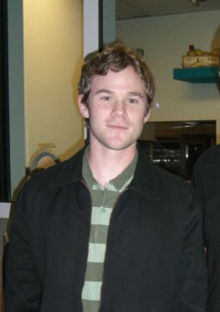 Actor Aaron Ashmore.
Actor Aaron Ashmore.
Two notable comedians hail from Brampton, Scott Thompson and Russell Peters. Thompson, one of the first openly gay television personalities in Canada, was part of The Kids in the Hall comedy troupe. Peters is an increasingly popular stand-up comedian who was raised in town, and later moved back. After winning a Gemini Award for his Comedy Now! special, he has relocated to Hollywood.
Comedic actor Michael Cera was born and raised in Brampton. He was a regular on the television series Arrested Development, and starred in the movies Superbad and Juno. Cera also starred in Scott Pilgrim vs. the World in which Brampton is mentioned as an in-joke. Shawn Ashmore (X-Men movie series, Terry Fox in Terry) and his twin brother Aaron Ashmore (Smallville) are Brampton-raised. Tyler Labine locally raised actor is currently the star of (Mad Love).Alan Thicke also hailed from Brampton.
Other Brampton-born or affiliated actors include Paulo Costanzo (Joey, Royal Pains), Gemini Award winner Kris Lemche (Emily of New Moon) and his younger brother Matt Lemche (The Boondock Saints II: All Saints Day), Sabrina Grdevich (Traders), Nicole Lyn (Student Bodies, married to Dulé Hill), film director Mark Penney, and David Phillips (Shark City, Green Guys), Gemini Award-winner George R. Robertson (Police Academy).
Of those best known as voice actors, Jordan Gavaris (Unnatural History), Brenna O'Brien (InuYasha, Zixx: Level Two). On-air media personalities Cassie Campbell, Chris Connor, Chris Cuthbert and Scott McGillivray have connections to the town.
Others
- Nathaniel Branden, psychotherapist, best known as a former associate of Ayn Rand and founder of the Nathaniel Branden Institute
- Philip J. Currie, palaeontologist and museum curator who helped found the Royal Tyrrell Museum of Palaeontology
- Kasandra Shepherd
- Doug Frith, former president of the Canadian Motion Picture Distributors Association
- Justine Blainey, fought in court for the right for females to participate in male sports
See also
- Brampton Board of Trade
- Brampton municipal election, 2006
- City of Brampton Arts Person of the Year
- List of airports in the Greater Toronto Area
References
- ^ Rayburn, Alan (2001). Naming Canada: Stories about Canadian Place Names. Toronto: University of Toronto Press. p. 45. ISBN 9780802082930. http://www.utppublishing.com/product.php?productid=859&cat=0&page=1.
- ^ a b c 2006 Statistics Canada data on Brampton, Ontario
- ^ [1]
- ^ a b "B-town's Beginning" in B-towns's 100th Anniversary as an Incorporated Town: 1873–1973, Brampton: The Corporation of the Town of Brampton and the Brampton Centennial Committee, 1973, originally published in Ross Cumming, ed., Historical Atlas of Peel County, n.p.: Walker and Miles, 1877.
- ^ a b c "Discover Brampton's History". City of Brampton. http://www.brampton.ca/en/Arts-Culture-Tourism/heritage/Pages/Brampton's-History.aspx. Retrieved 2010-04-08.
- ^ a b c d e f g Bost, John (30 December 2007). "Without a trace". Book Review. http://tomorrowstrust.ca/?p=1282. Retrieved 2010-04-08. "O’Hara tells the story of how the Dale Estate joined with the town to market the town as the “Flower Town of Canada” by instituting in 1963, The Flower Festival of Brampton, patterned after the great Rose Festival parade of Portland Oregon."
- ^ O'Hara, Dale (September 2007). Acres of Glass: The Story of the Dale Estate and How Brampton Became "The Flower Town of Canada". Eastendbooks. ISBN 9781896973395. http://acresofglass.com/. Retrieved 2010-04-08.
- ^ a b c "Brampton's FlowerTown Heritage". http://www.catchthespiritbrampton.com/flowertown.php. Retrieved 2010-04-08.
- ^ "Flower City Strategy". City of Brampton. http://www.brampton.ca/en/Business/planning-development/projects-studies/Pages/flower-city-strategy.aspx. Retrieved 2010-04-08. "On June 24, 2002, Council received and approved the “Flower City Strategy”, with the expressed purpose of recapturing of Brampton’s Floral heritage."
- ^ "Heritage". City of Brampton. http://www.brampton.ca/en/Arts-Culture-Tourism/heritage/Pages/welcome.aspx. Retrieved 2010-04-08.
- ^ "Environmental Responsibility". City of Brampton. http://www.brampton.ca/en/City-Hall/Strategic-Priorities/Pages/Environmental-Responsibility.aspx. Retrieved 2010-04-08. "The City is taking steps to reclaim our “flower town” roots through the Flower City Strategy, a multifaceted approach that strives to beautify Brampton, preserve its natural and cultural heritage and protect the environment. An important part of this strategy is adopting a sustainable environmental approach that combines conservation with urban development and design, naturalization and community landscaping."
- ^ Brampton Market Profile (pdf)
- ^ Ethnocultural Portrait of Canada Highlight Tables, 2006 Census
- ^ "Ethnocultural Portrait of Canada - Data table". 2.statcan.ca. 2010-10-06. http://www12.statcan.ca/english/census06/data/highlights/ethnic/pages/Page.cfm?Lang=E&Geo=CSD&Code=3521010&Data=Count&Table=2&StartRec=1&Sort=3&Display=All&CSDFilter=5000. Retrieved 2011-02-19.
- ^ 2006 Community Profiles
- ^ "Community Profiles from the 2006 Census, Statistics Canada - Census Subdivision". 2.statcan.ca. 2010-12-06. http://www12.statcan.ca/english/census06/data/profiles/community/Details/Page.cfm?Lang=E&Geo1=CSD&Code1=3521010&Geo2=PR&Code2=35&Data=Count&SearchText=Brampton&SearchType=Begins&SearchPR=01&B1=All&GeoLevel=&GeoCode=3521010. Retrieved 2011-02-19.
- ^ 2001 Statistics Canada census figures for religion
- ^ "Brampton, CY". Detailed Mother Tongue (103), Knowledge of Official Languages (5), Age Groups (17A) and Sex (3) for the Population of Canada, Provinces, Territories, Census Divisions and Census Subdivisions, 2006 Census — 20% Sample Data. Statistics Canada. 2007-11-20. http://www12.statcan.ca/english/census06/data/topics/RetrieveProductTable.cfm?ALEVEL=3&APATH=3&CATNO=&DETAIL=0&DIM=&DS=99&FL=0&FREE=0&GAL=0&GC=99&GK=NA&GRP=1&IPS=&METH=0&ORDER=1&PID=89202&PTYPE=88971&RL=0&S=1&ShowAll=No&StartRow=1&SUB=701&Temporal=2006&Theme=70&VID=0&VNAMEE=&VNAMEF=&GID=773675. Retrieved 2008-02-06.
- ^ "Address." Loblaw Companies Ltd. Retrieved on March 8, 2011. "Loblaw Companies Limited 1 President’s Choice Circle Brampton, Ontario, Canada L6Y 5S5"
- ^ http://www.bramptoncanadettes.com/main/tournaments_easter.html
- ^ Greater Toronto Airports Authority draft plan for Pickering Airport, Greater Toronto Airports Authority (2003). Retrieved on 2006-12-08.
- ^ Campbell, Mogan (2008-01-03). "Local boy not quite local enough for the CFL". Toronto Star. http://www.thestar.com/article/290632. Retrieved 2008-01-03.
- ^ Posted by Stephanie at February 22, 2006 1:20 PM (2006-02-22). "Yarn Harlot: Don't just stand there. Make coffee". Yarnharlot.ca. http://www.yarnharlot.ca/blog/archives/2006/02/22/dont_just_stand_there_make_coffee.html. Retrieved 2011-02-19.
- ^ Christine Boyanoski (1944-04-18). "Williamson, Curtis Albert". The Canadian Encyclopedia. http://www.thecanadianencyclopedia.com/index.cfm?PgNm=TCE&Params=A1ARTA0008605. Retrieved 2011-02-19.
- ^ "Caroline Armington - Artist, Fine Art, Auction Records, Prices, Biography for Caroline Helena (Wilkinson) Armington". Askart.com. http://www.askart.com/askart/a/caroline_helena_armington/caroline_helena_armington.aspx. Retrieved 2011-02-19.
- ^ Clara Hargittay (1925-05-29). "Bloore, Ronald". The Canadian Encyclopedia. http://www.thecanadianencyclopedia.com/index.cfm?PgNm=TCE&Params=A1ARTA0000833. Retrieved 2011-02-19.
- ^ "Mehta's film resonates with Indian women". The Star (Toronto). 2008-11-04. http://www.thestar.com/living/article/529749. Retrieved 2010-04-26.
External links
Local media
See also: Media in Peel Region- The Brampton Guardian, community newspaper
- The Brampton Bulletin, community newspaper
- The Brampton News, online-only news source
- Rogers Community Cable Brampton, television station

Caledon 
Halton Hills 
Vaughan  Brampton
Brampton 

Mississauga Toronto Municipalities of Peel Region, Ontario City of Brampton • Town of Caledon • City of MississaugaGreater Toronto Area Largest city: TorontoRegions 
Cities Towns Ajax • Aurora • Caledon • East Gwillimbury • Georgina • Halton Hills • Markham • Milton • Newmarket • Oakville • Richmond Hill • WhitbyTownships and municipalities Brampton Geography Buildings and structures Organization Events Politics Media Education Peel District School Board · Dufferin-Peel Catholic District School Board · Sheridan College, Brampton Campus · Algoma University, Brampton CampusTransportation Categories:- Brampton
- Populated places established in 1853
Wikimedia Foundation. 2010.


